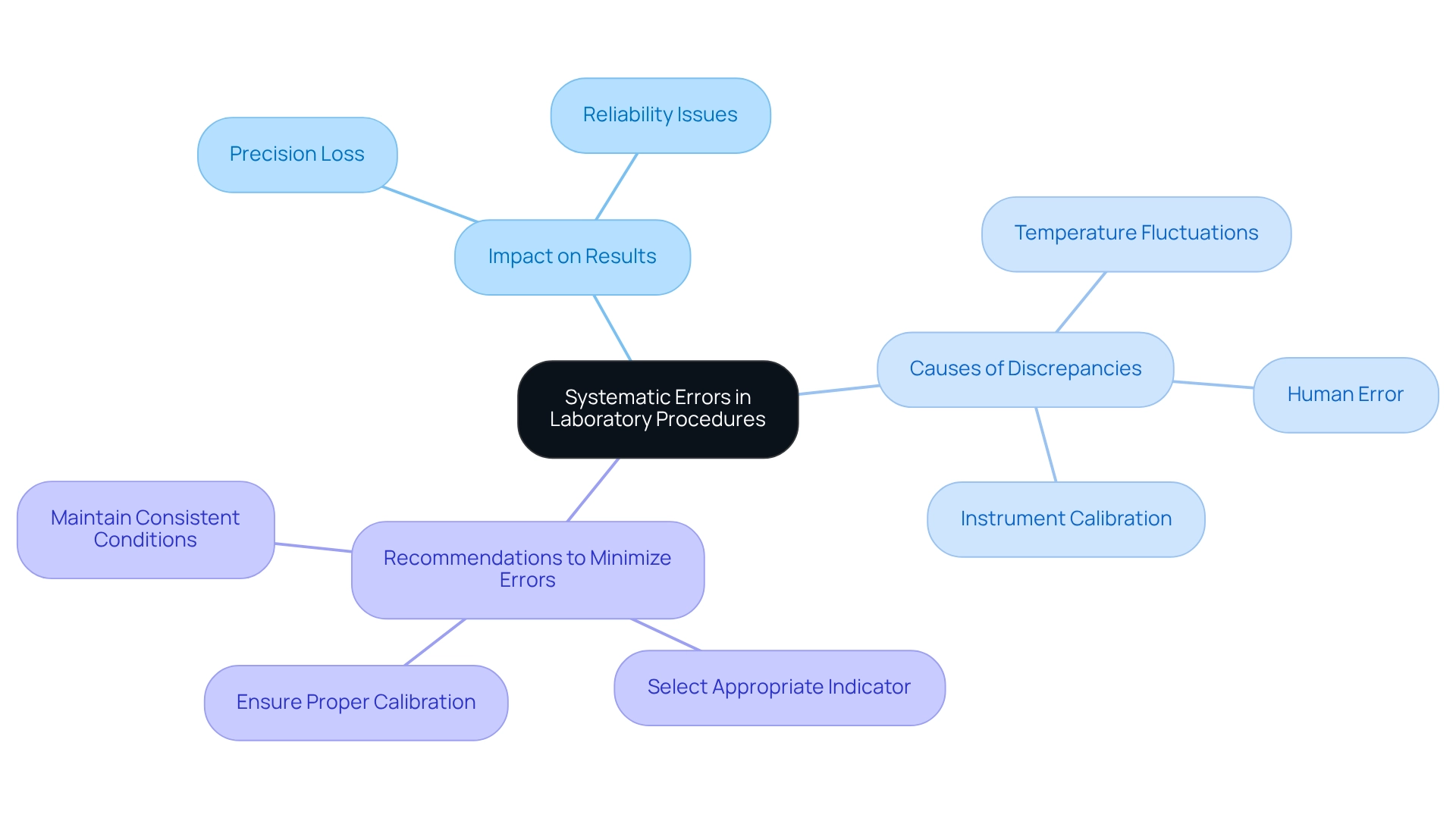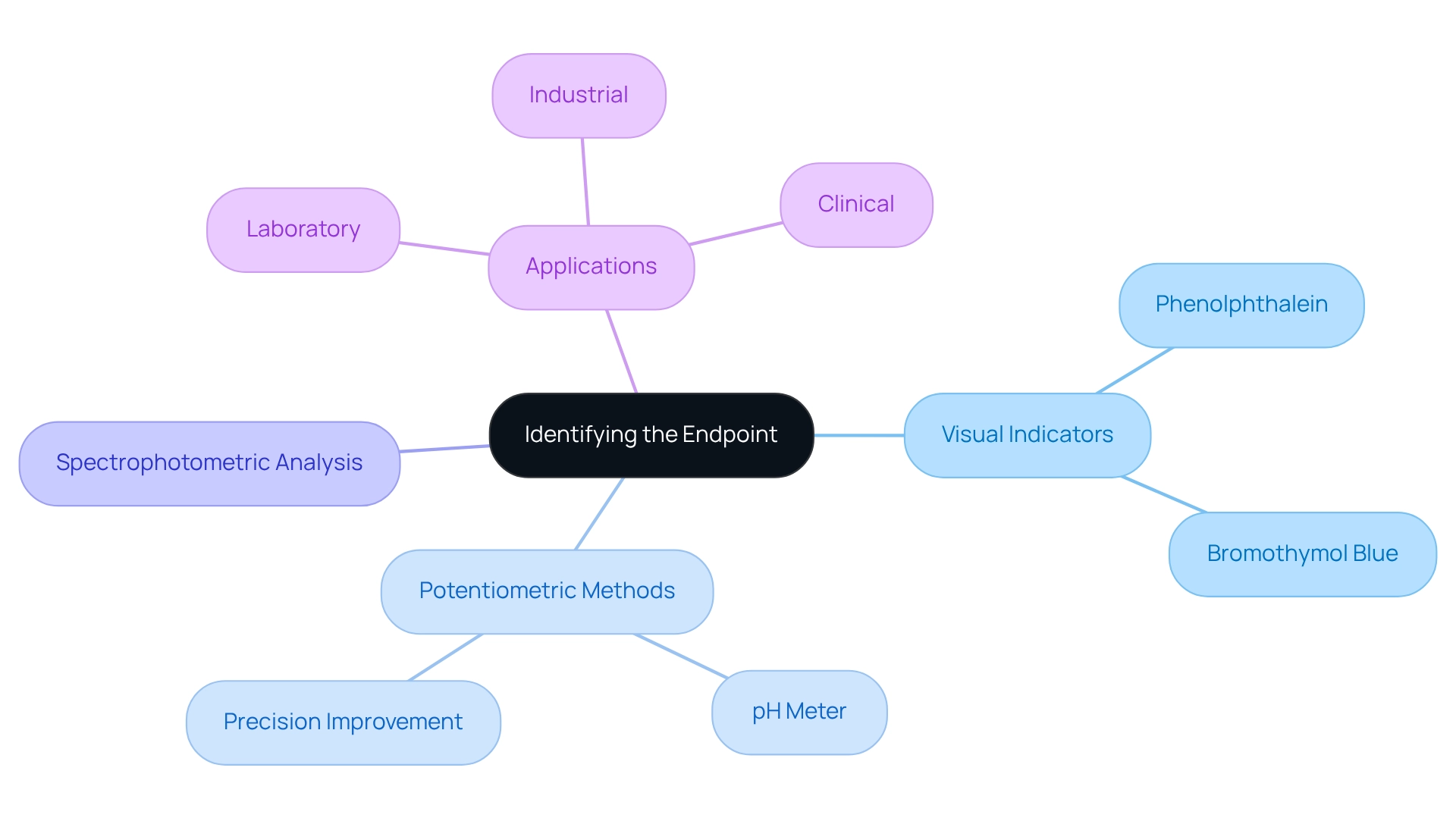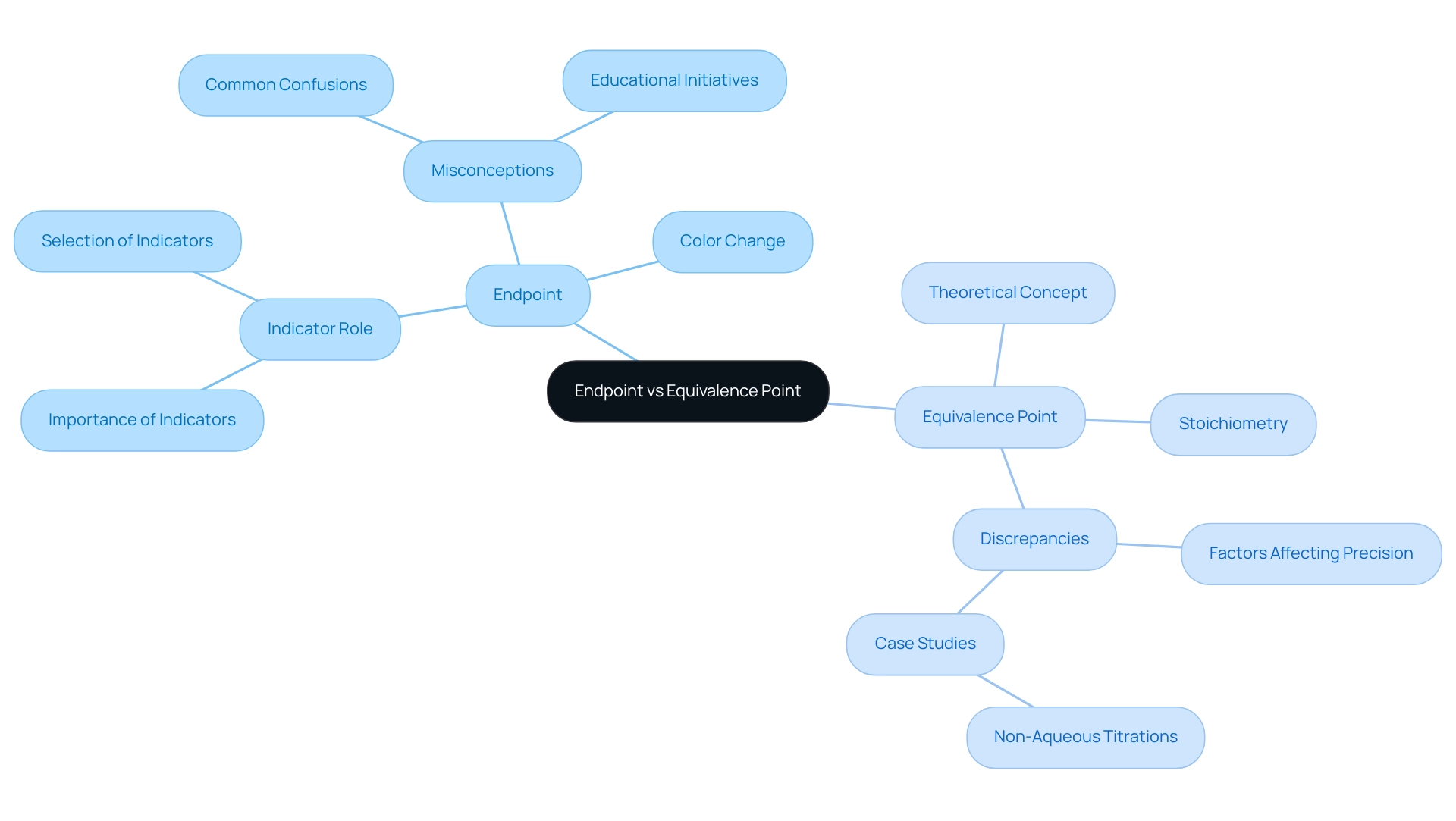Overview
This article clarifies the critical distinctions between the endpoint and equivalence point in titration, underscoring their importance in achieving precise analytical outcomes. The equivalence point signifies the theoretical balance of reactants, while the endpoint is marked by a discernible physical change, such as a color shift. Misunderstanding these concepts can lead to measurement errors, thereby compromising the reliability of results across various scientific applications, particularly in the pharmaceutical field. Understanding these differences is essential for ensuring accuracy in laboratory practices.
Introduction
In the intricate world of titration, comprehending the distinction between endpoint and equivalence point is vital for achieving precise and reliable results. These concepts extend beyond mere academic theory; they carry significant implications across various scientific disciplines, particularly in pharmaceuticals and environmental science.
As laboratories pursue accuracy in their analyses, the tools and techniques utilized in titration become indispensable. From the advanced Karl Fischer titrators provided by JM Science to the nuanced understanding of indicators and systematic errors, each component contributes to ensuring that measurements are not only accurate but also compliant with industry standards.
This exploration examines the importance of these concepts, addresses common misconceptions, and discusses practical applications, illuminating how meticulous attention to detail can enhance the integrity of scientific research and product quality.
JM Science Karl Fischer Titrators: Precision in Endpoint Determination
JM Science presents cutting-edge Karl Fischer titrators, meticulously engineered for precise moisture analysis, particularly in compliance with the Japanese Pharmacopoeia. Utilizing volumetric or coulometric methods, such as the Hiranuma Aquacounter AQV-300 Volumetric and AQ-300 Coulometric Titrators, these instruments provide accurate measurements of water content across a variety of pharmaceutical samples. The precision of Karl Fischer titrators is crucial; even slight deviations can lead to significant errors, jeopardizing product quality and regulatory compliance within . By harnessing advanced technology, JM Science ensures that their titrators deliver reliable and reproducible data, essential for meeting industry standards. Users consistently report favorable experiences, highlighting the vital role these instruments play in executing critical analyses.
The AQ-300 Coulometric Titrator boasts a compact design, facilitating ease of use in laboratory environments, while the AQV-300 Volumetric Titrator is outfitted with sophisticated measurement capabilities that enhance accuracy. Both models are constructed to adhere to rigorous compliance standards, establishing them as indispensable tools for moisture analysis in pharmaceutical laboratories.
Moreover, insights from the Industry Analysis Matrix reveal that Karl Fischer titrators, including the AQ-300, are capturing significant market share within , underscoring their essential function in ensuring product quality and compliance. With these advancements and the increasing acknowledgment of their significance, JM Science's Karl Fischer titrators remain at the forefront of moisture analysis technology.
Endpoint vs. Equivalence Point: Definitions and Key Concepts
In the process of titrating, the moment of balance occurs when the volume of reagent added is stoichiometrically equal to the quantity of analyte in the solution, signifying the completion of the reaction. This critical juncture is essential for accurate quantitative analysis. In contrast, the conclusion is marked by a noticeable alteration, often a color change due to an indicator such as phenolphthalein, signaling that the process should cease. However, the terminal does not always align with the , which can lead to significant measurement errors if not closely monitored.
As Inas Hasan Al-Khafaji from Baghdad University College of Science observes, 'The conclusion in a chemical analysis is the stage at which a noticeable physical change indicates balance,' emphasizing the need for a clear distinction between endpoint vs equivalence point.
Real-life laboratory examples illustrate the distinction of endpoint vs equivalence point:
- In a typical acid-base reaction, the use of phenolphthalein as an indicator can result in a noticeable color change at the conclusion, but the actual balance may vary based on specific reaction conditions.
- Furthermore, case studies, including the examination of ITC curves, reveal complexities such as the emergence of multiple sigmoids, which can further complicate the understanding of final values and equivalency.
Understanding the differences between endpoint vs equivalence point is crucial for laboratory managers and chemists alike, as these distinctions directly impact the accuracy of analytical results and the reliability of experimental data.
Systematic Errors: Impact of Endpoint and Equivalence Point Differences
Systematic mistakes in laboratory procedures often stem from discrepancies between the conclusion and the endpoint vs equivalence point, significantly impacting the precision of results. The choice of indicator is crucial; for example, phenolphthalein, commonly used in acid-base analyses, can lead to misinterpretation if the pH range does not align with the procedure's requirements. An unsuitable indicator may cause the color change to occur either prematurely or too late, resulting in inaccurate determination of the endpoint vs equivalence point.
Various factors contribute to these discrepancies, including:
- Fluctuations in temperature
- Improper calibration of instruments
- Human error in measurement readings
A study has highlighted that systematic errors can lead to discrepancies of up to 10% in analytical results, emphasizing the necessity for meticulous attention to detail. This deviation can critically affect the reliability of results in pharmaceutical applications, where precision is paramount.
Expert consultations have demonstrated that addressing these systematic errors can significantly enhance laboratory practices. Laboratories that have conducted systematic evaluations of reported improved precision and consistency in their results. As noted by laboratory professional Stefan Kaus, "We tried to show how you can achieve [correct and reproducible results](https://xylemanalytics.com/en/company/blog/blog/2022/09/how to get correct and reproducible results in titration) through simple and comprehensible measures." This underscores the importance of precise measurement techniques.
Furthermore, resources from the Royal Society of Chemistry provide valuable materials focused on laboratory techniques, including volumetric analysis, further highlighting the importance of correct practices in achieving reliable outcomes.
To minimize discrepancies, it is essential to:
- Select the appropriate indicator
- Ensure proper calibration of equipment
- Maintain consistent environmental conditions
By adopting these practices, laboratories can achieve more dependable measurement outcomes, ultimately contributing to the integrity of their analytical results.

Identifying the Endpoint: Techniques and Indicators
Determining the conclusion in volumetric analysis is crucial and involves various techniques, particularly in understanding the differences between , including visual indicators, potentiometric methods, and spectrophotometric analysis. Common indicators, such as phenolphthalein and bromothymol blue, are extensively utilized due to their unique color shifts at specific pH levels, effectively signaling the conclusion.
However, for enhanced accuracy, understanding the difference between endpoint vs equivalence point in potentiometric analysis is increasingly favored. This technique employs a pH meter to continuously monitor the solution's pH, enabling precise identification of the endpoint vs equivalence point, and minimizing potential errors. Recent advancements in potentiometric methods have significantly improved precision and garnered trust among professionals, making them essential in both laboratory and industrial applications.
In manufacturing processes, for instance, this measurement technique is pivotal for quality assurance, ensuring that products adhere to stringent specifications. Titration transcends mere laboratory technique; it serves as a bridge connecting theoretical chemistry with practical applications in our world.
Moreover, ongoing research underscores the necessity for consensus on clinical endpoint vs equivalence point in severe infections, further emphasizing the importance of precise measurement techniques in critical healthcare scenarios. As the field progresses, experts advocate for the integration of diverse techniques to enhance the identification of endpoint vs equivalence point.
The effectiveness of various indicators remains a topic of discussion among chemists, with many asserting that the choice of an indicator can profoundly influence the reliability of measurement results. By remaining informed about current trends and employing expert techniques, laboratories can achieve more reliable quantitative analyses in their titrations.

Titration Curves: Visualizing Endpoint and Equivalence Point Differences
Titration curves serve as a visual representation of the pH of a solution in relation to the amount of titrant introduced, effectively illustrating the connection between the final result and balance. Initially, as the titrant is added, the pH changes gradually until a sharp rise occurs, marking the balancing stage. The endpoint, marked by of the indicator, usually occurs shortly after the equivalence point.
Analyzing these curves is crucial for chemists as it allows them to determine the optimal volume of titrant needed and to identify any differences when considering the endpoint vs equivalence point. Such discrepancies may arise from various factors, including the selection of pH indicators, which must correspond with the expected pH range of the drug solution. Statistics indicate that the careful selection of pH indicators is crucial for achieving precise measurement outcomes.
In the realm of pharmaceutical chemistry, acid-base analyses are vital for ensuring the accuracy and safety of drug formulations by quantifying active ingredients and monitoring pH levels. For instance, assessment curves play a pivotal role in quality control, stability testing, and formulation development, as underscored in the case study titled '[Applications in Pharmaceutical Chemistry](https://xylemanalytics.com/en/company/blog/blog/2022/09/how to get correct and reproducible results in titration).' This underscores their significance in pharmaceutical practices.
JM Science Inc. provides a diverse array of high-quality titrators and accessories designed to enhance the accuracy of these analyses, ensuring that pharmaceutical lab managers are equipped with the essential tools for efficient measuring processes. Continuous advancements in measurement techniques, including the integration of machine learning and artificial intelligence, are set to improve conditions and predict results, further enhancing the precision of these analyses.
As a renowned chemist once remarked, 'Innovation in traditional techniques breeds a new age of discovery; where the past teaches us, the future awaits our ingenuity.' By visualizing the distinctions between the final stage and the corresponding stage, chemists can refine their methodologies, leading to improved precision in measurement outcomes and ultimately fostering progress in research and healthcare.
Common Misconceptions: Clarifying Endpoint and Equivalence Point
A common misunderstanding in titration is the notion that the endpoint vs equivalence point are the same. In reality, the balance stage is a theoretical concept defined by stoichiometry, indicating the precise moment when the reactants have fully reacted. Conversely, the conclusion is marked by a noticeable alteration, such as a color change, which may not precisely align with the matching stage. Furthermore, it is a widespread misconception that all analyses can achieve a flawless correspondence between these two points. Factors including the choice of indicator, reaction kinetics, and the nature of the substances involved can lead to discrepancies between the two.
Surveys indicate that approximately 30% of chemists confuse the endpoint vs equivalence point, highlighting the need for targeted educational initiatives. For instance, case studies on non-aqueous analyses demonstrate how selecting suitable solvents and indicators can clarify these concepts and enhance results. In these studies, it was shown that utilizing can significantly improve the precision of measurement outcomes.
As Meenakshi Dhanawat states, "Indicators are substances that change color in response to chemical reactions, particularly during quantitative analyses, allowing the determination of an endpoint." This underscores the importance of understanding how indicators function in relation to the balancing stage.
Moreover, incorporating educational materials that emphasize measurement precision can aid in clarifying these misunderstandings, ultimately resulting in more dependable outcomes in laboratory environments. By fostering a deeper understanding of these critical concepts, laboratories can enhance their analytical precision and contribute to more effective scientific practices.

Practical Applications: Importance of Endpoint and Equivalence Point in Science
The concepts of endpoint vs equivalence point are fundamental in numerous scientific applications, particularly in the pharmaceutical sector, where precise measurement is crucial for drug formulation and quality control. JM Science Inc. offers premium titrators and an extensive range of HPLC solutions, ensuring accurate measurements that are essential for confirming the active ingredient's presence at the correct concentration—vital for both efficacy and safety. Such precise measurement not only guarantees compliance with regulatory standards but also enhances the reliability of pharmaceutical products, which is essential for patient health.
In the realm of environmental science, this methodology is pivotal in evaluating water quality by quantifying the concentration of pollutants or nutrients. Environmental scientists often rely on analytical methods, bolstered by JM Science's innovative solutions, including HPLC columns and accessories, to assess the impact of contaminants on ecosystems, thereby guiding remediation strategies. The Volumetric Karl Fischer method, utilized when moisture content surpasses 1-2%, is indispensable for analyzing pharmaceutical products, as moisture levels can influence shelf life and stability. This method, along with the Coulometric method, is critical for moisture determination, ensuring pharmaceuticals are stored under optimal conditions.
Real-world applications of these principles are illustrated in case studies, such as employing the Karl Fischer method for moisture determination in pharmaceuticals, which highlights the necessity of maintaining optimal storage conditions. Furthermore, expert opinions emphasize , facilitated by JM Science's advanced titrators and HPLC solutions, is not merely a procedural step but a foundational element that impacts the overall quality and safety of pharmaceutical products. As one environmental scientist remarked, "Titration is essential for understanding the nuances of water quality, allowing us to make informed decisions that protect our ecosystems." By comprehending and applying these principles, scientists can make informed decisions that significantly advance both research and public health.
Conclusion
The distinction between endpoint and equivalence point is integral to the accuracy of titration processes, significantly impacting various fields, particularly pharmaceuticals and environmental science. A comprehensive understanding of these concepts empowers chemists to conduct precise quantitative analyses, ensuring that measurements align with industry standards. The utilization of advanced tools, such as JM Science's Karl Fischer titrators, not only enhances reliability but also ensures compliance, underscoring the critical importance of selecting appropriate indicators and techniques to minimize systematic errors.
Furthermore, addressing common misconceptions surrounding these terms is essential for laboratory professionals. By fostering a clearer understanding of the differences, laboratories can enhance their analytical precision, leading to more reliable results. The integration of innovative methods and ongoing education can further refine titration practices, ultimately contributing to improved product quality and safety.
In conclusion, meticulous attention to detail in identifying endpoints and equivalence points not only enhances the integrity of scientific research but also plays a pivotal role in ensuring public health and environmental safety. As the landscape of analytical chemistry evolves, embracing these principles will empower scientists to make informed decisions that drive advancements across various scientific disciplines.




